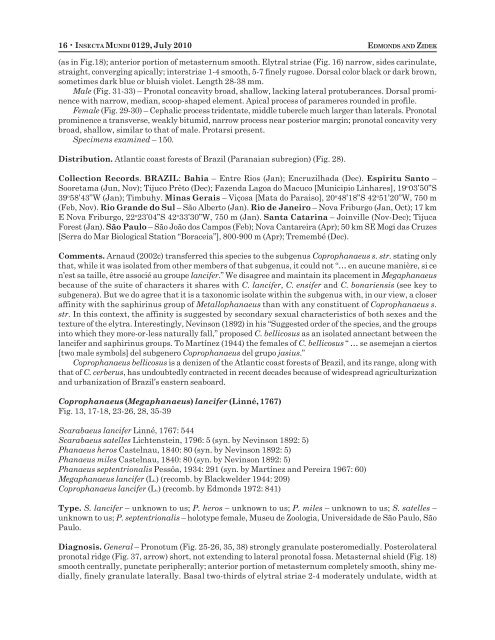insecta mundi - Center for Systematic Entomology
insecta mundi - Center for Systematic Entomology
insecta mundi - Center for Systematic Entomology
Create successful ePaper yourself
Turn your PDF publications into a flip-book with our unique Google optimized e-Paper software.
16 • INSECTA MUNDI 0129, July 2010 EDMONDS AND ZIDEK<br />
(as in Fig.18); anterior portion of metasternum smooth. Elytral striae (Fig. 16) narrow, sides carinulate,<br />
straight, converging apically; interstriae 1-4 smooth, 5-7 finely rugose. Dorsal color black or dark brown,<br />
sometimes dark blue or bluish violet. Length 28-38 mm.<br />
Male (Fig. 31-33) – Pronotal concavity broad, shallow, lacking lateral protuberances. Dorsal prominence<br />
with narrow, median, scoop-shaped element. Apical process of parameres rounded in profile.<br />
Female (Fig. 29-30) – Cephalic process tridentate, middle tubercle much larger than laterals. Pronotal<br />
prominence a transverse, weakly bitumid, narrow process near posterior margin; pronotal concavity very<br />
broad, shallow, similar to that of male. Protarsi present.<br />
Specimens examined – 150.<br />
Distribution. Atlantic coast <strong>for</strong>ests of Brazil (Paranaian subregion) (Fig. 28).<br />
Collection Records. BRAZIL: Bahia – Entre Rios (Jan); Encruzilhada (Dec). Espiritu Santo –<br />
Sooretama (Jun, Nov); Tijuco Prêto (Dec); Fazenda Lagoa do Macuco [Municipio Linhares], 19 o 03’50”S<br />
39 o 58’43”W (Jan); Timbuhy. Minas Gerais – Viçosa [Mata do Paraiso], 20 o 48’18”S 42 o 51’20”W, 750 m<br />
(Feb, Nov). Rio Grande do Sul – São Alberto (Jan). Rio de Janeiro – Nova Friburgo (Jan, Oct); 17 km<br />
E Nova Friburgo, 22 o 23’04”S 42 o 33’30”W, 750 m (Jan). Santa Catarina – Joinville (Nov-Dec); Tijuca<br />
Forest (Jan). São Paulo – São João dos Campos (Feb); Nova Cantareira (Apr); 50 km SE Mogi das Cruzes<br />
[Serra do Mar Biological Station “Boraceia”], 800-900 m (Apr); Tremembé (Dec).<br />
Comments. Arnaud (2002c) transferred this species to the subgenus Coprophanaeus s. str. stating only<br />
that, while it was isolated from other members of that subgenus, it could not “… en aucune manière, si ce<br />
n’est sa taille, être associé au groupe lancifer.” We disagree and maintain its placement in Megaphanaeus<br />
because of the suite of characters it shares with C. lancifer, C. ensifer and C. bonariensis (see key to<br />
subgenera). But we do agree that it is a taxonomic isolate within the subgenus with, in our view, a closer<br />
affinity with the saphirinus group of Metallophanaeus than with any constituent of Coprophanaeus s.<br />
str. In this context, the affinity is suggested by secondary sexual characteristics of both sexes and the<br />
texture of the elytra. Interestingly, Nevinson (1892) in his “Suggested order of the species, and the groups<br />
into which they more-or-less naturally fall,” proposed C. bellicosus as an isolated annectant between the<br />
lancifer and saphirinus groups. To Martínez (1944) the females of C. bellicosus “ … se asemejan a ciertos<br />
[two male symbols] del subgenero Coprophanaeus del grupo jasius.”<br />
Coprophanaeus bellicosus is a denizen of the Atlantic coast <strong>for</strong>ests of Brazil, and its range, along with<br />
that of C. cerberus, has undoubtedly contracted in recent decades because of widespread agriculturization<br />
and urbanization of Brazil’s eastern seaboard.<br />
Coprophanaeus (Megaphanaeus) lancifer (Linné, 1767)<br />
Fig. 13, 17-18, 23-26, 28, 35-39<br />
Scarabaeus lancifer Linné, 1767: 544<br />
Scarabaeus satelles Lichtenstein, 1796: 5 (syn. by Nevinson 1892: 5)<br />
Phanaeus heros Castelnau, 1840: 80 (syn. by Nevinson 1892: 5)<br />
Phanaeus miles Castelnau, 1840: 80 (syn. by Nevinson 1892: 5)<br />
Phanaeus septentrionalis Pessôa, 1934: 291 (syn. by Martínez and Pereira 1967: 60)<br />
Megaphanaeus lancifer (L.) (recomb. by Blackwelder 1944: 209)<br />
Coprophanaeus lancifer (L.) (recomb. by Edmonds 1972: 841)<br />
Type. S. lancifer – unknown to us; P. heros – unknown to us; P. miles – unknown to us; S. satelles –<br />
unknown to us; P. septentrionalis – holotype female, Museu de Zoologia, Universidade de São Paulo, São<br />
Paulo.<br />
Diagnosis. General – Pronotum (Fig. 25-26, 35, 38) strongly granulate posteromedially. Posterolateral<br />
pronotal ridge (Fig. 37, arrow) short, not extending to lateral pronotal fossa. Metasternal shield (Fig. 18)<br />
smooth centrally, punctate peripherally; anterior portion of metasternum completely smooth, shiny medially,<br />
finely granulate laterally. Basal two-thirds of elytral striae 2-4 moderately undulate, width at



